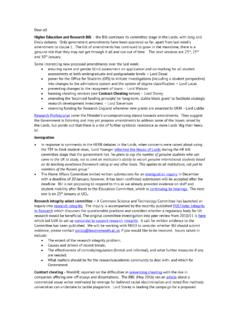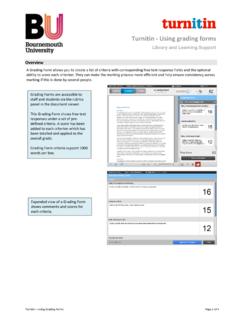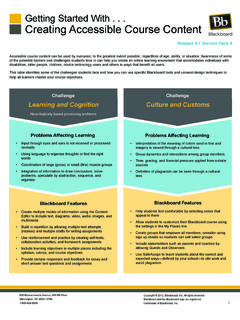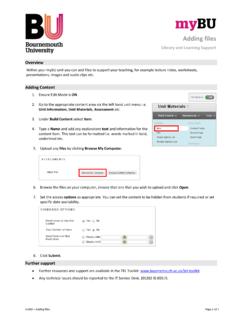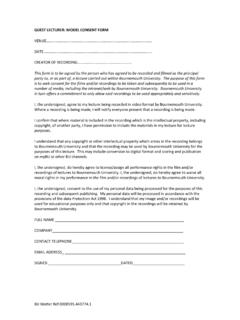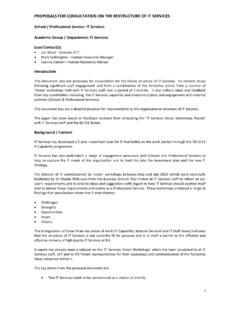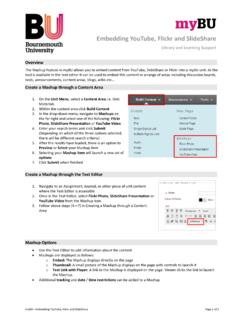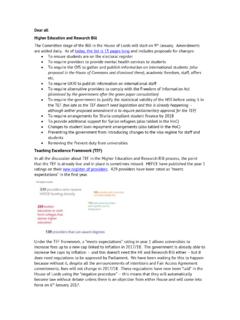Transcription of Introduction to Focus Groups - Home - Intranet SP
1 Introduction to Focus Groups Prof. Edwin van Teijlingen BU Graduate School 2 Outline Focus group Research Its origin Underlying philosophy Why and when (not) to use it? Some practical issues / examples Strength & weaknesses Its place within qualitative methods 3 4 Origins Focus group concept dates back to World War II. Sociologists investigated how military propaganda films were being received by audiences. They learnt that, with proper prodding, people can identify the exact reason certain scenes, lines, or phrases make them think or act in a certain way.
2 F. Luntz (1994) 5 Origins in marketing Focus Groups are often regarded as a quick and convenient way to collect data from several people simultaneously. (Kitzinger J. Introducing Focus Groups , BMJ 1995; 311: 299-302). BUT this is oversimplification! 6 Origins in Marketing Focus Groups used to test new products on potential buyers/ users, or try new policies on electorate, etc. Would you buy a new pen? 7 Underlying philosophy I Focus group relies on group discussion. Allows FG participants to disagree or agree with each other. Provide insight into how group thinks, about range of views/ideas, and inconsistencies that exist in a particular community in terms of beliefs, experiences and practices.
3 8 Underlying philosophy II People formulate ideas in reaction to others in group , not just the researcher. The group makes FG discussion different from one-to-one interviews with people, there is a synergetic effect. Not just economies of scale, interviewing several people at the same time for the price of one . 9 When to use Focus Groups Focusing on the why question. Preparing for quantitative studies In parallel with quantitative studies: explain / examine in-depth meaning findings of quantitative studies. as part of triangulation. 10 Example Focus group research Women described in a study using Focus Groups the conflicts they experienced in trying to put healthy food on the table, but also ensuring that they produced a diet that was eaten by the rest of the family.
4 Mackie, LJ, Wood, RC & Gregory S. (1993) Women defining health: food, diet & body image. Health Educ Res 8(1) 35-41. 11 When Focus Groups Macnaghten and Myers suggested: Focus Groups work best for topics people could talk about to each other in their everyday lives-but don t. Macnaghten P, Myers G. Focus Groups , In: Seale C, Giampietri G, Jaber F, Silverman D. (Eds) Qualitative Research Practice Sage: London, 12 Searching for meaning Quality rather than quantity Explorative studies of new topics How do midwives, health visitors, etc. learn about new dietary guidelines?
5 When to us it I 13 In preparation for quantitative studies, find: right/best questions to ask; best order to ask questions; options to add to multiple choice questions; etc. When to us it II 14 Prepare quantitative studies / example Focus Groups to find issues /options /choices for Discrete Choice Experiment s questionnaire on rural maternity care. women s preferences for: location of maternity care, provider, time, etc. (Tucker, Farmer, Kiger, Ryan, et al.) When to us it III 15 Interpret quantitative studies Help explain the statistical findings from a study with a large data set.
6 Reasons why students report relatively low use of web-based health promotion interventions designed & aimed at them? (Douglas, Brindle et al.) When to us it IV 16 Triangulation I Triangulation may help validate findings. Originally this meant using three methods at the same time but it can be used to describe any study using more than one technique on the same population. Mason J. Qualitative Researching (2nd edn). London: Sage, 2002 17 Triangulation II Use Focus Groups in conjunction with other (qualitative) methods. For example, use a questionnaire study on large sample of population, do interviews with sub-sample and Focus Groups with (other) sub-sample of the same population.
7 18 Small group of people (8-15) to discuss interactively under guidance of facilitator (pre-specified) issues or topics. Composed of six to nine participants, according to Iowa State University web site: Focus group composition I 19 Select Focus Groups Groups with: common factor (parents of pupil in year 7; attending antenatal classes in Southampton; etc.) But which is diverse within a group with regard to other characteristics that might affect opinions, views, experiences, such as mix of ages, genders, jobs, locality, prior knowledge). Additionally, you should avoid: People of extremely different rank, socioeconomic status, antagonistic viewpoints.
8 Focus group composition II 20 One person should not be allowed to dominate discussion. Some have group members write their ideas down without consulting others before discussion starts to eliminate bias and bring out many different viewpoints. Loud and quiet ones I 21 Facilitator must create a relaxed, informal atmosphere where people feel free to express their opinions. For example, ask: What does the rest think about .. Loud and quiet ones II 22 Sampling qualitative methods Purposive / theoretical sampling Criterion / quota sampling Random sampling Convenience sampling Snowball sampling 23 People who know each other: friendship Groups ; work or class mates; same ward/club/street; etc.
9 People don t know each other but are similar: mixture of first year, second & third students; pregnant women & new mothers in same group ; etc. Focus group composition I 24 Focus group composition III As with all qualitative research exact number of FGs may fluctuate. You need at least one Focus group for every sub- group want to analyse separately ( male /female social workers, male /female nurses, etc.) Preferably more than one Focus group for each sub- group to avoid bias. 25 People who are similar in same group and run various Groups in same study to avoid major confrontation.
10 Different people together to have widest range of opinion to encourage debate. Focus group composition II 26 The start of a group Especially people who do not know each other well, have a quick introductions so that group members can begin to form a relationship with rest of group and with you. Also helps to make them feel at ease Help identify individuals on tape for transcribing. 27 Focus Groups have been used with young people in sexual health studies. (Wight 1994; Hyde et al. 2005; Roberts et al. 2005). Focus Groups promote self-disclosure through mutual support.
